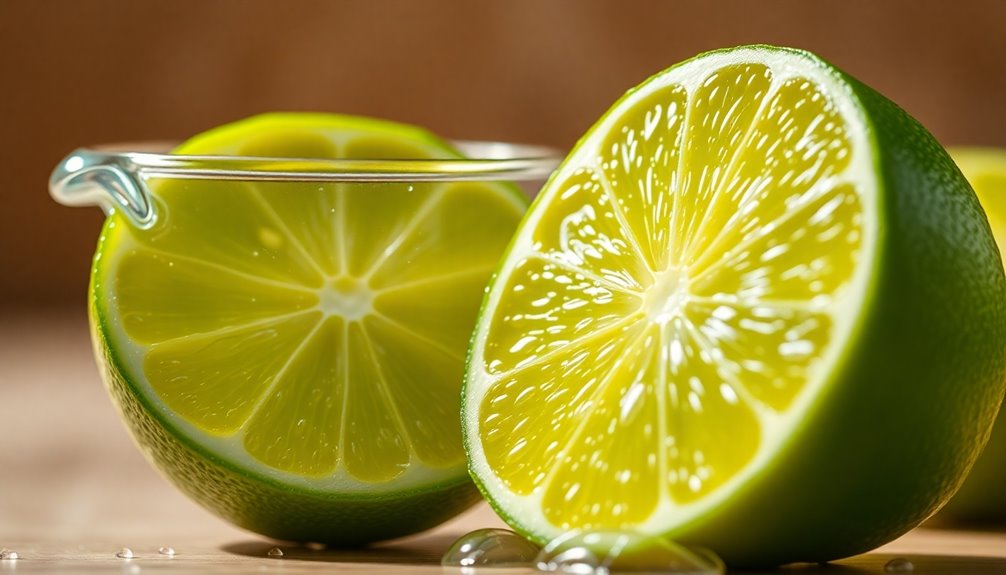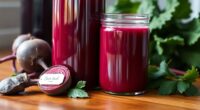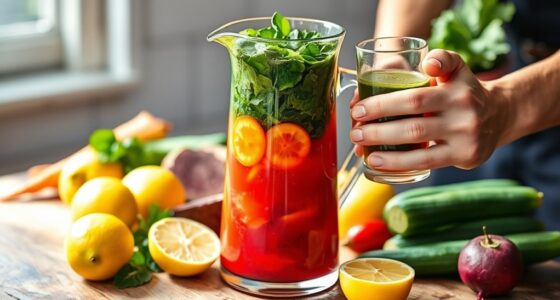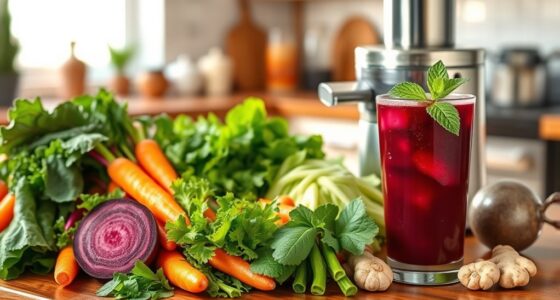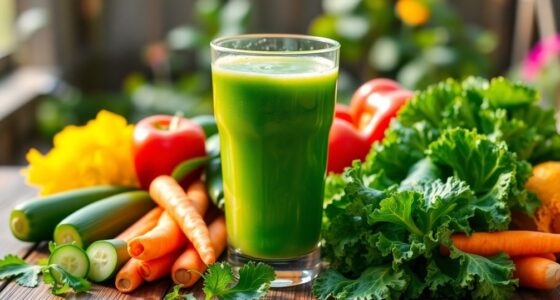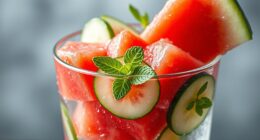A medium lime typically yields about 1 ounce of juice, while larger limes can produce up to 2 ounces. Smaller limes also yield around 1 ounce. Freshness and ripeness play key roles in juice quantity, with heavier limes generally containing more juice. Techniques like warming, rolling, and using juicers can enhance extraction. So, if you're keen to maximize your lime juice, there's more to explore about choosing and using limes effectively.
Key Takeaways
- Medium and small limes yield approximately 1 ounce of juice each, while large limes can yield up to 2 ounces.
- Ripe, heavier limes generally contain more juice than lighter, less ripe ones.
- Persian limes often yield around 2 ounces, while Key limes yield about 1 ounce.
- Freshness, firmness, and smooth skin are indicators of juiciness in limes.
- Juicing techniques like rolling, warming, and using a juicer enhance overall juice extraction.
Understanding Lime Juice Yield
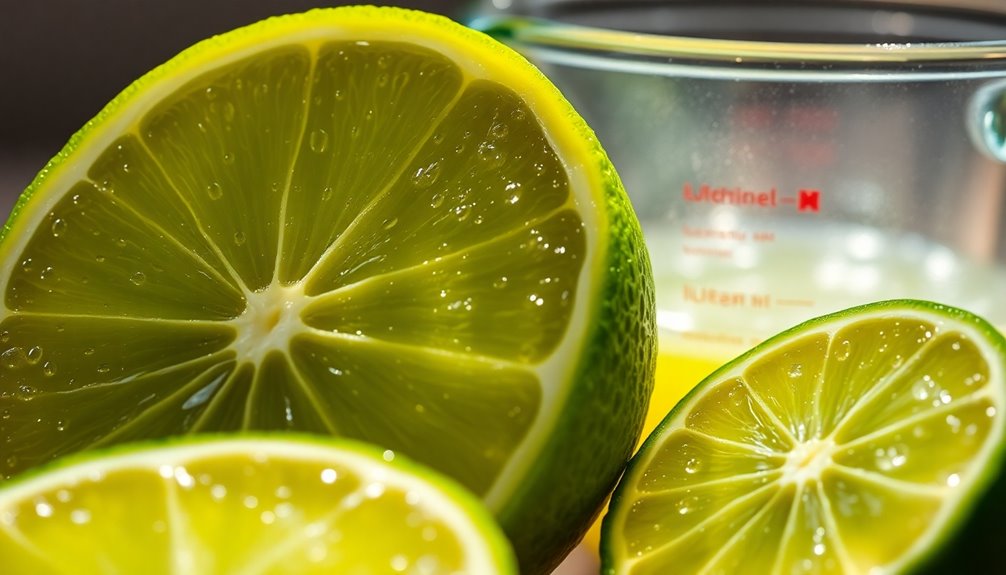
Have you ever wondered how much juice you can get from a lime? A medium lime typically yields about 1 ounce of juice, while a small lime gives you around 1 ounce too.
If you're lucky enough to have a large lime, you might extract up to 2 ounces of juice! The juicing technique you use can also impact your yield. For instance, rolling the lime before cutting it can help loosen the internal membranes, maximizing juice extraction.
Ripeness plays a role too; riper limes tend to have more juice. Don't forget about Key limes; they generally yield about 1 ounce of juice as well.
Factors Influencing Juice Quantity
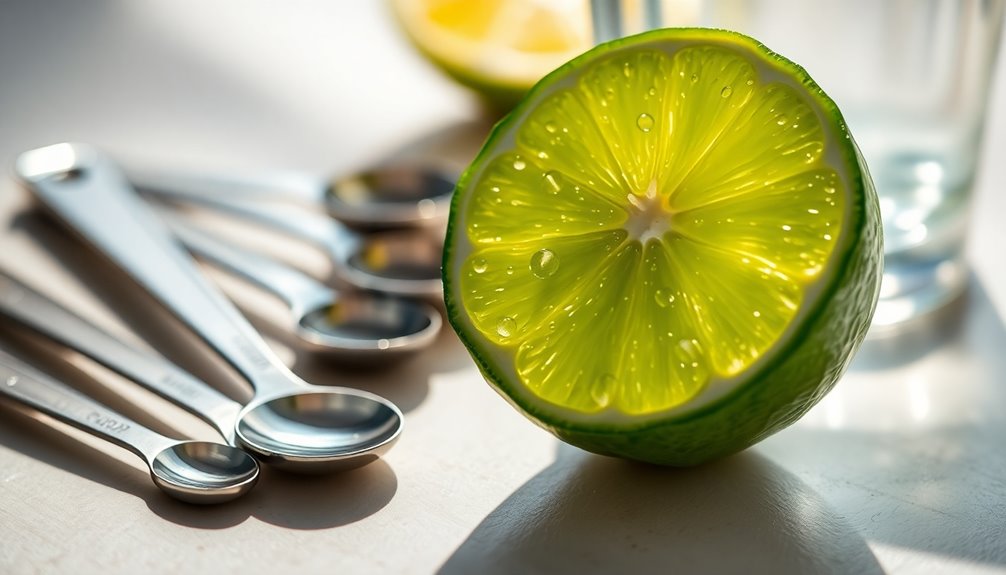
The amount of juice you can extract from a lime isn't just about its size; several factors play a significant role. Here are three key elements that influence juice yield:
- Freshness: Fresher limes yield more juice, so always opt for the freshest citrus fruit available.
- Ripeness: Ripe limes, especially heavier ones for their size, typically have a higher juice content. Persian limes often provide around 2 ounces, while Key limes give you about 1 ounce.
- Maximizing Juice: Rolling the lime before cutting and using juicers or forks can help release more juice.
Choosing the Right Lime for Optimal Juice
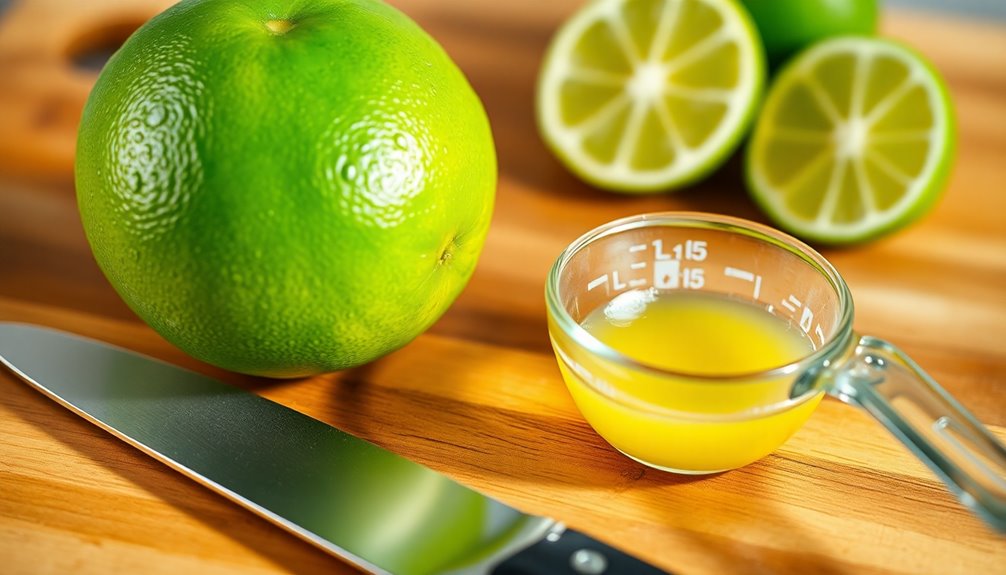
When you're picking limes, look for ones that feel firm and tight, as this usually means they're fresh and juicy.
Pay attention to the color; greener limes tend to be riper and pack better flavor.
Firmness Indicates Freshness
Choosing the right lime can greatly enhance your juice yield, especially when you focus on firmness. Firm limes are typically fresher and yield more juice than their softer counterparts, which may indicate overripeness or spoilage.
Here are some tips for selecting the best limes:
- Check the Texture: Look for smooth skins; bumpy or rough surfaces often mean the lime is past its prime.
- Feel the Density: Choose heavier limes that feel dense for their size, as they usually contain more juice.
- Inspect for Spots: Avoid limes with brown spots, as these often signify aging, leading to reduced juice yield.
Color and Ripe Indicators
To guarantee you pick the best limes for juicing, pay close attention to their color and ripeness. Fresh limes should be bright green with smooth skin, indicating maximum juiciness.
Look for firmness; choose limes that feel tight and heavy, as these are more likely to yield juice. Avoid any limes with brown spots or a soft texture, since these are ripe indicators of overripe fruit that may not have the tangy flavor you desire.
Greener limes tend to be riper and offer better flavor, enhancing your recipes. Always compare firmness among limes, as squishy ones can signal older fruit that yields less juice.
Choosing wisely will guarantee you get the best limes for your needs.
Size Versus Juice Yield
Understanding how size affects juice yield can help you select the best limes for your recipes. Here are some tips to guarantee you get the most juice and vibrant flavor:
- Check Weight: Heavier limes usually contain more juice than lighter ones.
- Choose Firm Limes: Look for firm limes with a smooth rind for a fresh taste and better juice content.
- Know Your Varieties: Persian limes yield about 2 ounces of juice, while juicier Key limes offer roughly 1 ounce. Additionally, the nutritional benefits of using lime juice can enhance the overall health profile of your dishes.
Techniques for Effective Juicing
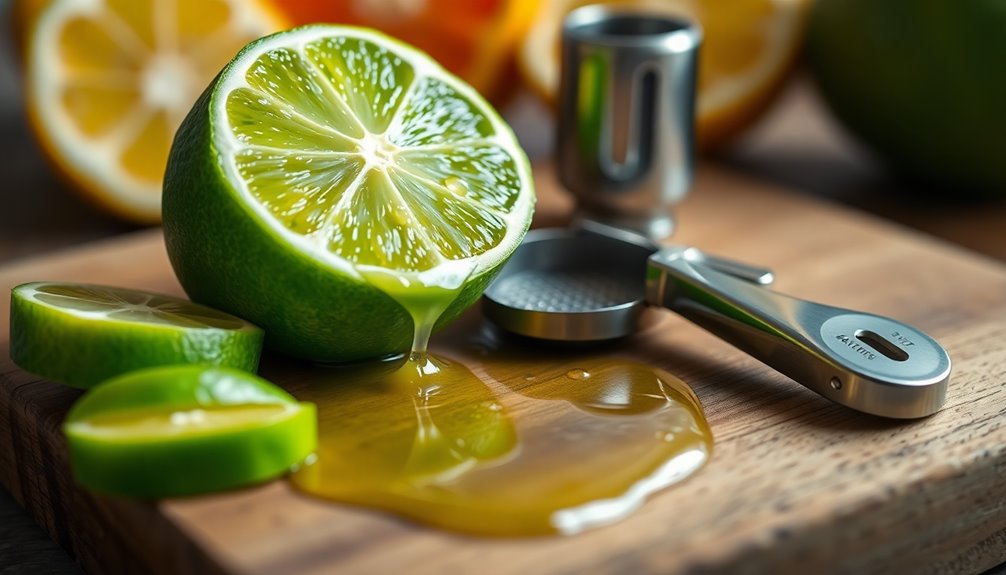
Maximize your lime juice yield with a few simple techniques. Start by warming the lime in the microwave for 10-15 seconds to soften it, which leads to greater juice extraction. Next, roll the lime on a solid surface before cutting it in half lengthwise. This helps break down the internal membranes, granting you better access to the juice-filled membranes and maximizing yield. After cutting, use a handheld juicer or citrus press for efficient juice extraction. For any remaining juice, poke each lime half with a fork to release more. Additionally, remember that hydration support from citrus fruits can enhance your overall health.
| Technique | Benefit | Tools Needed |
|---|---|---|
| Warming the lime | Increases overall yield | Microwave |
| Rolling the lime | Breaks down membranes | Solid surface |
| Cutting in half | Access to juice-filled membranes | Knife |
| Poking with a fork | Releases remaining juice | Fork |
Culinary Uses of Lime Juice
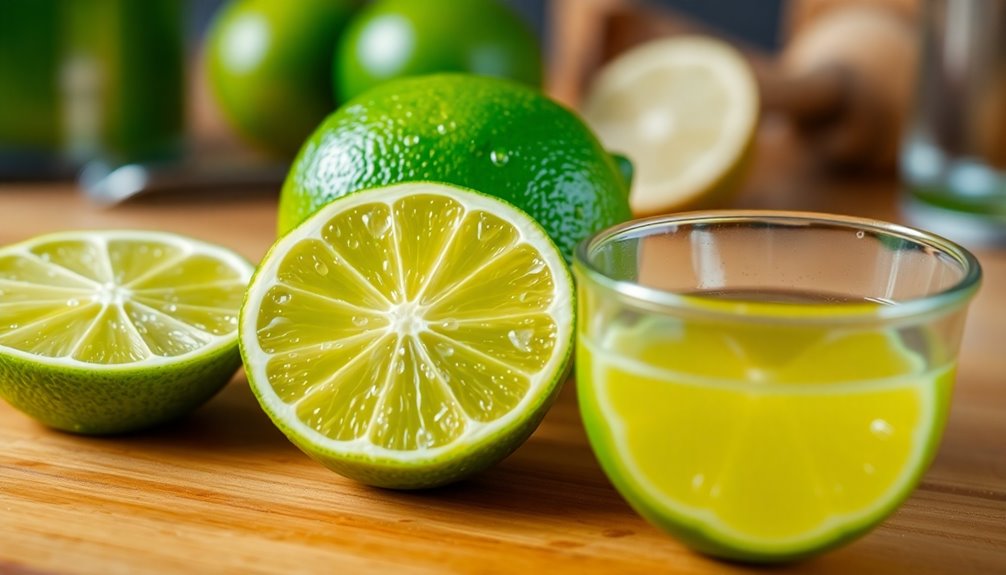
Lime juice adds a vibrant kick to a wide range of dishes, transforming flavors with its bright acidity. You can use the juice of one lime, which yields about two tablespoons, to enhance your culinary creations.
Here are three fantastic ways to incorporate fresh lime juice:
- Marinades: Use lime juice to tenderize meats while adding a unique flavor that balances richness.
- Cocktails: Fresh lime juice is essential for classic cocktails like margaritas, giving them that invigorating zing.
- Soups and Ceviches: A splash of lime juice brightens up soups and seafood dishes, making them irresistible.
With its versatility and vitamin C content, lime juice is a must-have in your kitchen arsenal. Additionally, lime juice can be used in herb-infused cocktails for an extra burst of flavor and aroma.
Nutritional Benefits of Lime Juice
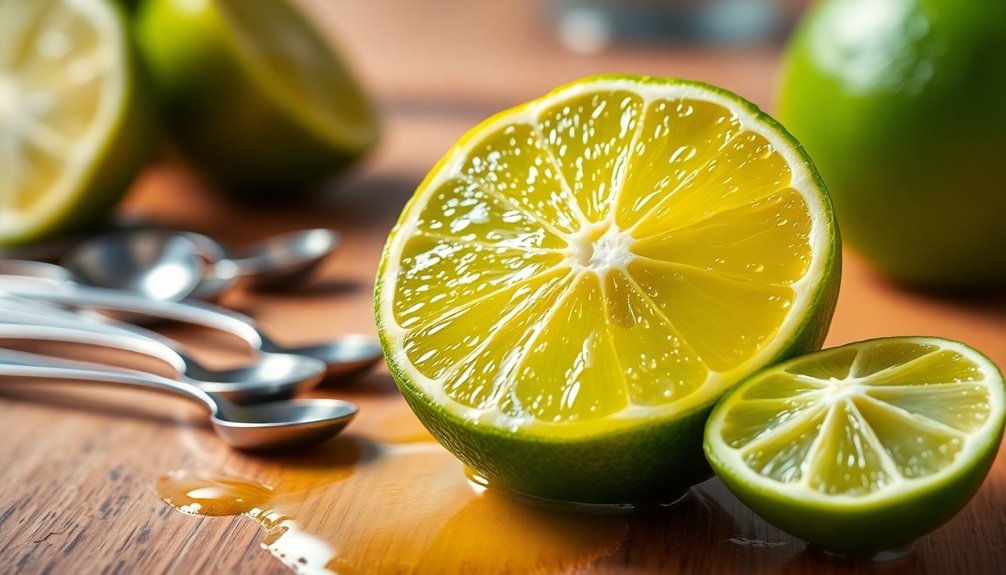
While you might think of lime juice primarily as a culinary staple, its nutritional benefits are equally impressive. Just one ounce of lime juice offers about 30% of your daily Vitamin C, boosting your immune system and promoting overall health. Its antioxidants, like flavonoids and limonoids, combat oxidative stress, protecting your body from free radicals. The acidity of lime juice aids digestion by stimulating digestive juices, while it also enhances hydration, replenishing electrolytes, especially in hot weather. Plus, the Vitamin C in lime juice supports collagen production, promoting healthy skin.
| Benefit | Description |
|---|---|
| Vitamin C | Boosts immune system |
| Antioxidants | Fights oxidative stress |
| Digestion | Stimulates digestive juices |
| Hydration | Replenishes electrolytes |
Frequently Asked Questions
How Much Lime Juice Does One Lime Yield?
When you squeeze one medium lime, you can expect it to yield about 2 tablespoons, which is roughly 1 fluid ounce of lime juice.
If you're working with a smaller lime, it'll usually give you around 1 ounce, while a larger lime can produce up to 2 ounces.
Keep in mind that factors like freshness and size can affect how much juice you get, so results might vary slightly.
How Much Real Lime Juice Equals 1 Lime?
When you’re wondering how much real lime juice equals one lime, it really depends on the size of the lime. On average, a medium lime yields about 2 tablespoons of juice, while larger limes can provide up to 3 tablespoons. If you find yourself without fresh limes, a handy tip is to remember that 1 lime typically translates to approximately 30-45 ml of lime juice. For precise cooking and mixing, understanding lime juice quantity explained will help ensure your recipes turn out perfectly every time.
On average, a medium lime gives you about 1 ounce of juice, while a small lime offers around 1 ounce as well, and a large lime can give you up to 2 ounces.
To get a consistent amount, always opt for fresh limes; they yield more juice than older ones.
How Many Ounces of Lime Juice Are in a Lime?
Did you know that a medium lime usually yields about 2 tablespoons of juice?
When you're wondering how many ounces of lime juice are in a lime, the answer often lies between 1 to 2 ounces, depending on its size.
Most medium limes will give you around 1.5 ounces.
How Much Juice Is in One Key Lime?
When you squeeze one key lime, you can expect to get about 1 ounce of juice.
These limes are smaller and more acidic than their Persian counterparts, which means you might find their flavor is more tart and floral.
If you're making a recipe that calls for lime juice, keep in mind you'll likely need 2 to 3 key limes to match the juice yield of just one medium Persian lime.
Conclusion
So, whether you're squeezing a plump Persian lime or a tiny Key lime, the mystery of juice yield can surprise you. While a single lime might hold only 1 to 2 ounces, that small burst of tangy goodness packs a powerful punch in your dishes and drinks. Embrace the zesty allure of lime juice, and remember: its vibrant flavor can transform the simplest recipe into a culinary masterpiece, proving that sometimes, less really is more!
Susannah expertise lies in researching and compiling evidence-based content on juicing, nutrition, and overall health. She is committed to ensuring that The Juicery World offers accurate, up-to-date, and trustworthy information to empower readers to take control of their health. Susannah’s goal is to inspire individuals to embrace juicing as a way to nourish their bodies and live their best lives.

